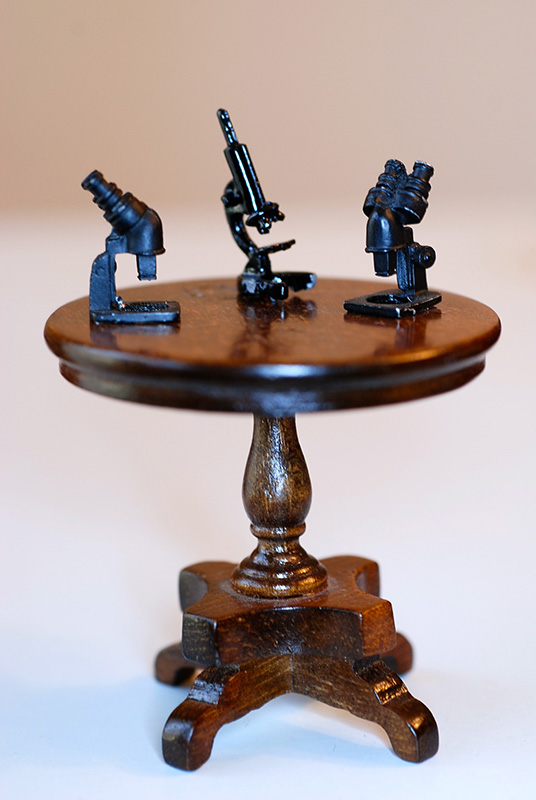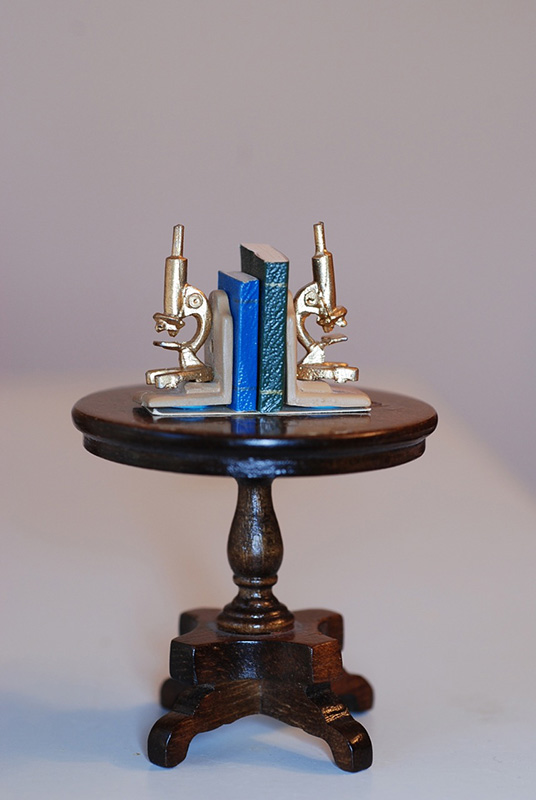
IN THE DOLL HOUSE:
THE MICROSCOPES OF
THE LAND OF LILLIPUT
Manuel del Cerro, Princeton, NJ, USA
Dietmar R. Krause, Princeton, NJ, USA
We have found nothing in the literature that provides information on the microscopes of Lilliput. In this article we correct this regrettable omission.
We can say with certainty that a Lilliputian doctor or nature lover (which can be one and the same person) who is living in his or hers doll house, needs not be deprived of microscopes because of size considerations. Quite the contrary, a variety of microscopes, both stereo binoculars, as well as traditional monoculars, some made of black finished metal, others made of brass, all those are available for use by the Lilliputians. So, let's then discuss some of the microscopes of Lilliput.
Sitting on a table of appropriate dimensions (5.5 cm in diameter, 5.0 cm in height) we see three microscopes [Fig. 1]. Likely, a microscopical soirée has been planned as those commonly held in Europe and America in the late 1800s. Of the three microscopes on the table one is a horseshoe base, monocular instrument with a revolving turret holding three objectives; the type that was standard in biology and clinical laboratories for almost a century (Moe, 2004). This instrument is 2.3 cm tall and weights 2.36 gr. The other two microscopes are dissection scopes of the Common Main Objective (CMO) type, recently described in these pages (Kreindler, 2012). The CMOs are 1.6 cm tall and weight 2.81 gr each.

Figure 1. The microscopes of Lilliput ready for use.
The evidence just reviewed shows that microscopy is actively pursued in Lilliput. Does that mean all is well in the Lilliputian microscope world? Unfortunately not. We have found that some Lilliputians use microscopes, brass ones, as bookends! Yes, as bookends! [Figure 2] It is true that in our own world some misguided souls have also used microscopes as bookends, and even as lamp bases! However, given the scarcity of examples of this form of microscope desecration, we can end with a happy note: most of the microscopes of Lilliput appear to be used to enhance the intellect and to search for beauty.

Figure 2. A rare instance of misuse of microscopes in Lilliput.
SOURCES
Moe, Harald (2004) The Story of the Microscope. Rhodos, Denmark. (English translation of the 1990 Danish original, updated by the author).
Kreindler, R. Jordan (2012)
The
stereo microscope. Part 3- Common main objective stereo
microscopes. MicScape, September Issue
ACKNOWLEDGMENT
One of the authors (MdC) gratefully acknowledges Dolores and William DeCoste, from Pittsford, NY, for the gift of the microscopes of Lilliput.
FEEDBACK
The Authors would like to hear from the readership about any other forms of doll microscopes. All comments and corrections are welcome.
Microscopy UK Front
Page
Micscape
Magazine
Article
Library
Published in the December 2012 edition of Micscape Magazine.
Please report any Web problems or offer general comments to the Micscape Editor .
Micscape is the on-line monthly magazine of the Microscopy UK website at Microscopy-UK .
© Onview.net Ltd, Microscopy-UK, and all contributors 1995 onwards. All rights reserved. Main site is at www.microscopy-uk.org.uk .